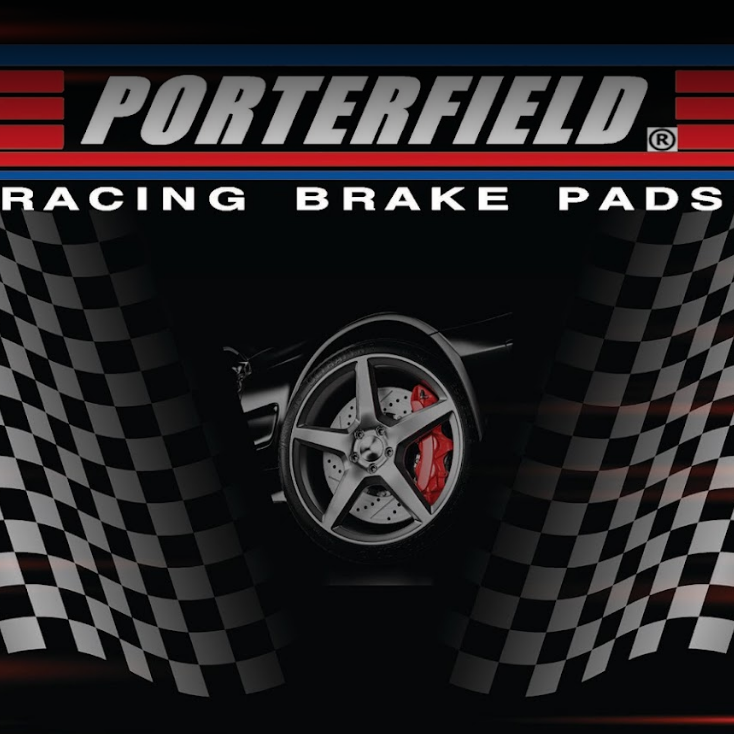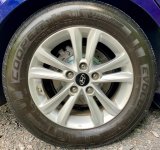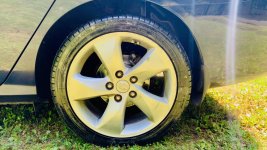Looking into replacing my pads and rotors, on my 2013 Ford Edge. I guess I want to look for coated rotors. So they don't rust so easily.. living on social security, not looking to spend a bunch of money, I don't do a whole lot of driving, maybe about 10,000 miles a year.. but I do want something decent on there.. I was looking at these obviously don't know nothing about them.. Power Stop CRK5452 Coated Brake Rotor & Ceramic Brake Pads- front & rear https://www.amazon.com/dp/B07JKR8SH...abc_3QBV27DJAJ4M4BBH4B8Q?_encoding=UTF8&psc=1
You are using an out of date browser. It may not display this or other websites correctly.
You should upgrade or use an alternative browser.
You should upgrade or use an alternative browser.
Brake pads and rotors.
- Thread starter Scott S
- Start date
I don't know about the rotors you listed but I just bought a powerstop set up for our Ford Transit van and found the kit considerably cheaper at Summit Racing, as opposed to Amazon. Same day shipping on it, too.
Scott S
Thread starter
That's because I picked out the coated rotors. I think the z23 is the non-coated..
Powerstop coated rotors are awesome! I never used their pads, though.
Did you check Rock Auto online? They have a variety of Power Stop gear for my vehicle. I used something else, but I would be open to using PowerStop in the future.
I did the Powerstop z23 Evolution 4 axle upgrade on both on the Hyundais, with coated drilled and slotted rotors and powerstop z23 pads, 6 months and thousands of miles later, they work even better then new, no vibrations, great feel, less dust, and zero rust!. I'm very happy with them. 
Attachments
Couldn't you buy rotors that weren't coated, and add the coating yourself to save some $$$ ?. And use whatever pads that do the trick?. I've bought no-brand parts off from Ebay and found they last as long as the expensive ones I used to buy. But if you live in an area where you drive thru salt water or by the Ocean, I think coated rotors are a good Idea.,,,
Or just leave off the coating entirely for more savings.Couldn't you buy rotors that weren't coated, and add the coating yourself to save some $$$ ?.
Do you want coated rotors for appearance reasons? I have a couple cars where the rotors are 99% hidden, so I don't care what they look like.... And a couple cars with fancy aluminum wheels that show every speck of rust. So for those I get the fancy coated rotors.
Coated will slow down corrosion on the non pad contact areas of the rotors for sure. It's all I use now on my fleet.
I haven't used the Powerstop on my vehicles yet but they held up well on the D in L's car.
I haven't used the Powerstop on my vehicles yet but they held up well on the D in L's car.
I would recommend a Centric axle pack with their "Premium" rotors and Posi-quiet Ceramic pads, but they cost more than powerstop.
Only the non-contact surfaces are painted with their "e-coat"

Only the non-contact surfaces are painted with their "e-coat"

I have been having issues with those pads - two have come back within 5-10K for pedal pulsation issues.Posi-quiet Ceramic pads
Have they been bedded properly?I have been having issues with those pads - two have come back within 5-10K for pedal pulsation issues.
They were bedded in accordance with the OEM service procedure. The PosiQuiets are replacement for OEM pads and do not require any special bed-in.Have they been bedded properly?
Actually, PosiQuiets Ceramic (which most people buy) require bedding, as I have had them, to transfer a proper layer of pad material onto the the rotor, as an adherent type of pad.They were bedded in accordance with the OEM service procedure. The PosiQuiets are replacement for OEM pads and do not require any special bed-in.
See also Stoptech's white paper (which has been posted from time to time) from the God of Formula SAE, Carroll Smith.
"With one qualifier, presuming that the hub and wheel flange are flat and in good condition and that the wheel bolts or hat mounting hardware is in good condition, installed correctly and tightened uniformly and in the correct order to the recommended torque specification, in more than 40 years of professional racing, including the Shelby/Ford GT 40s – one of the most intense brake development program in history - I have never seen a warped brake disc. I have seen lots of cracked discs, (FIGURE 1) discs that had turned into shallow cones at operating temperature because they were mounted rigidly to their attachment bells or top hats, (FIGURE 2) a few where the friction surface had collapsed in the area between straight radial interior vanes, (FIGURE 3) and an untold number of discs with pad material unevenly deposited on the friction surfaces - sometimes visible and more often not. (FIGURE 4)"
In fact every case of "warped brake disc" that I have investigated, whether on a racing car or a street car, has turned out to be friction pad material transferred unevenly to the surface of the disc. This uneven deposition results in thickness variation (TV) or run-out due to hot spotting that occurred at elevated temperatures. In order to understand what is happening here, we will briefly investigate the nature of the stopping power of the disc brake system.
Prevention
There is only one way to prevent this sort of thing - following proper break in procedures for both pad and disc and use the correct pad for your driving style and conditions. All high performance after market discs and pads should come with both installation and break in instructions. The procedures are very similar between manufacturers. With respect to the pads, the bonding resins must be burned off relatively slowly to avoid both fade and uneven deposits. The procedure is several stops of increasing severity with a brief cooling period between them. After the last stop, the system should be allowed to cool to ambient temperature. Typically, a series of ten increasingly hard stops from 60mph to 5 mph with normal acceleration in between should get the job done for a high performance street pad. During pad or disc break-in, do not come to a complete stop, so plan where and when you do this procedure with care and concern for yourself and the safety of others. If you come to a complete stop before the break-in process is completed there is the chance for non-uniform pad material transfer or pad imprinting to take place and the results will be what the whole process is trying to avoid. Game over.
His advice is irrelevant for stock performance brake pads. Maybe for race pads.Actually, PosiQuiets Ceramic (which most people buy) require bedding, as I have had them, to transfer a proper layer of pad material onto the the rotor, as an adherent type of pad.
See also Stoptech's white paper (which has been posted from time to time) from the God of Formula SAE, Carroll Smith.
OEM pads and rotors when installed at the factory, do not receive the break-in procedure that he describes. They function fine. As long as you start the material transfer process using a reasonable method (10-15 stops from 30-35 mph with cooldown in between), normal driving will allow the material to transfer onto the rotor surface.
I have tried his method and have found no improvement. In fact, it sometimes causes the pads to permanently glaze.
Scott S
Thread starter
That's pretty much why I'm getting the coated rotors. Because you could see the rotors through the wheels.Or just leave off the coating entirely for more savings.
Do you want coated rotors for appearance reasons? I have a couple cars where the rotors are 99% hidden, so I don't care what they look like.... And a couple cars with fancy aluminum wheels that show every speck of rust. So for those I get the fancy coated rotors.
Scott S
Thread starter
Which ones I've seen a few different ones?I have used Raybestos pads and coated rotors on the last 2 I did, an 09 Impala and my Wrangler. Both performed as well as the OEM at a better price.
personally I've had great success with the Bosch quietcast rotors, yes they are coated for rust. Usually last about 3-4 years here in Michigan which I'm impressed with! When installing the QuietCast rotors and measuring the run-out they've always been almost zero on my run-out gauge! The marketing said they added carbon to the cast iron mix for better braking performance.. I thought it was just marketing hype, no actually it does provide better braking grip!Which ones I've seen a few different ones?
And the price isn't bad at all either.. might want to look into those while you're shopping..
but brake pads, it all depends what do you want? Do you just want something decent, and no bedding in required.. I'd recommend akebono's line of ceramic pads. They even have a high performance line of ceramic pads..
my personally? I enjoy porterfields r4-s carbon/kevlar performance pad. But it's a street pad, unlike their race pads that need to be warmed up before they work.. the S in r4-s means street.. very important to get the right ones.. anyway.. It's a small shop in california that has been making pads since the 1980's. I think they started out racing corvettes. I've enjoyed their pads for a long time, double the friction from stock, works in cold weather (been used in -30 degree weather, fahrenheit), and lasts like 50k miles.. not bad for a performance pad, but not cheap, what is, when it's good? lol..
here is their link.. porterfield-brakes.com

Home
Porterfield Brakes. Your one-stop shop for racing and performance brakes and parts. Shop our large inventory of Motorsports auto parts today.
Similar threads
- Replies
- 23
- Views
- 704
- Replies
- 37
- Views
- 6K
- Replies
- 23
- Views
- 2K
- Replies
- 7
- Views
- 1K




